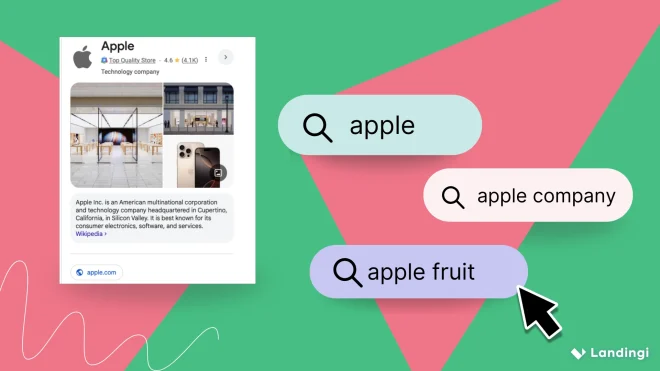Black hat SEO refers to a range of tactics aimed at increasing search engine rankings by bending (or outright breaking) search engine rules. These techniques focus on fast results rather than long-term strategy, often working by manipulating how algorithms read and rank pages and influence search engine results.
While black hat SEO tactics aren’t illegal, they do go against search engine guidelines and carry the risk of penalties. Still, it continues to be used by marketers in competitive industries who are looking for shortcuts, testing limits, or operating in spaces where high turnover is expected.
In this guide, you’ll find a clear explanation of what black hat SEO is, how it works, why some people rely on it, and how it compares to other search engine optimization approaches.

What is Black Hat SEO in Google?
Black hat SEO in Google refers to any technique that violates the search engine’s terms and guidelines to manipulate rankings artificially.
Instead of improving a site’s visibility through high-quality content or a good user experience, black hat methods rely on shortcuts designed to influence how Google’s algorithms evaluate a site. These can include cloaking, keyword stuffing, link farms, doorway pages, and more.
Penalties can include a drop in rankings, partial removal from search results, or complete deindexing. Over the years, Google has introduced updates like Panda, Penguin, and the Helpful Content System to detect and filter out these methods more effectively.
However, this hasn’t eliminated black hat SEO – it’s simply made it more complex. Those who use it tend to work in short-term cycles, targeting fast wins and accepting that penalties may come eventually. The tactics evolve constantly as Google adjusts, and the risk is part of the process.

Why is Black Hat SEO Important?
Black hat SEO is important because it plays a visible role in how people approach search rankings, especially in competitive and fast-paced markets. Even though it contradicts search engine rules, black hat SEO continues to be a part of the SEO landscape. It helps explain why certain websites rise quickly, why some agencies promise fast results, and how marketers in aggressive niches operate. Whether one chooses to use these methods or not, understanding them makes it easier to analyze the strategies others might be using.
In many cases, people using black hat SEO techniques aim for speed: they want visibility now, not months from now. And in industries where ranking first can directly impact revenue (think affiliate sites, e-commerce stores, or short-lived campaigns) this makes black hat tactics appealing.
There’s also a practical reason to study black hat SEO: awareness. Marketers may come across tools, freelancers, or offers that promise specific results using unknown methods. Being able to recognize black hat signals helps with vetting services and understanding the trade-offs involved.
Overall, black hat techniques are part of how search marketing operates. Whether someone avoids it or experiments with it, it’s something worth knowing, because others are using it, and it’s not going away anytime soon.
They use black hat tricks. You’ll use better tools. Start building pages that play hard and play fair.
4 Easy Steps for Implementing Black Hat SEO Methods
Black hat SEO methods can be implemented through a combination of on-page manipulation, deceptive content practices, and link-building shortcuts. Below are four foundational steps commonly used to apply these tactics.
1. Over-Optimize Your Content with Keyword Stuffing
The first step often involves pushing as many exact-match keywords into a page as possible – within paragraphs, headers, meta tags, image filenames, and anchor text. The goal is to maximize keyword density to make the page appear hyper-relevant for specific searches.
In practice, this can result in unnatural or repetitive content. For example, a sentence like “Buy best hiking boots cheap hiking boots online hiking shoes hiking gear cheap boots” would be typical of an aggressively stuffed page. Older search engines could be fooled by this tactic, but modern algorithms like Google’s are designed to detect and downrank such behavior.
Despite that, keyword stuffing is still sometimes used for low-competition queries or short-term campaigns where the goal is fast ranking, not quality or user satisfaction. Black hat SEO focuses on such manipulative tactics to achieve quick rankings, often at the expense of quality and user experience.
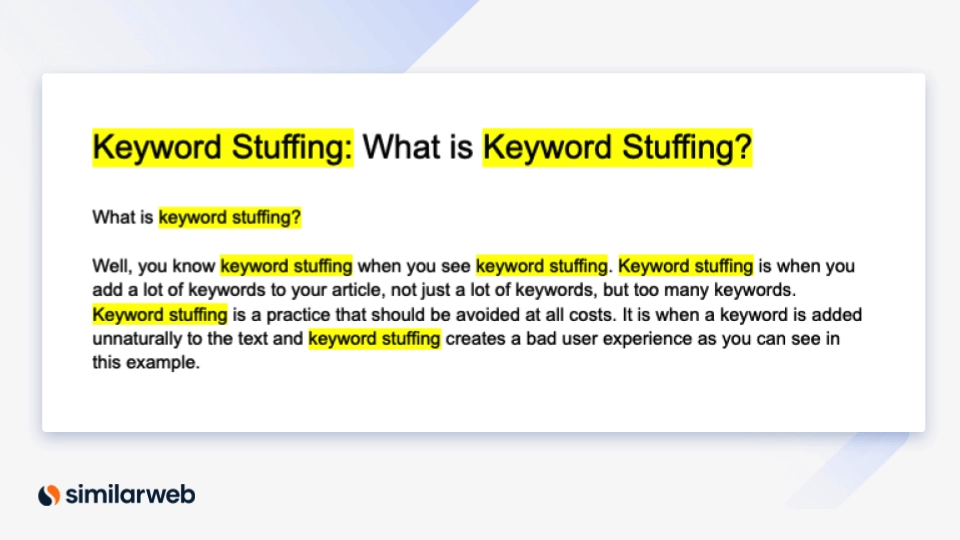
2. Use Cloaking to Present Different Content to Users and Crawlers
Cloaking is the technique of showing one version of a page to search engine crawlers and another to users. This is done through server-side scripting or user-agent detection. For instance, Googlebot might see a page full of keyword-rich text and backlinks, while a regular visitor is redirected to a sales page, video, or even unrelated content.
The aim is to rank for specific keywords without having to serve that content to actual users. While it’s clearly against search engine guidelines, cloaking is still used in some niches where churn-and-burn strategies are the norm. Detection technologies have improved, but sophisticated cloaking setups still attempt to avoid being flagged. Black hat SEO practitioners often employ cloaking techniques to gain quick rankings, despite the risks involved.
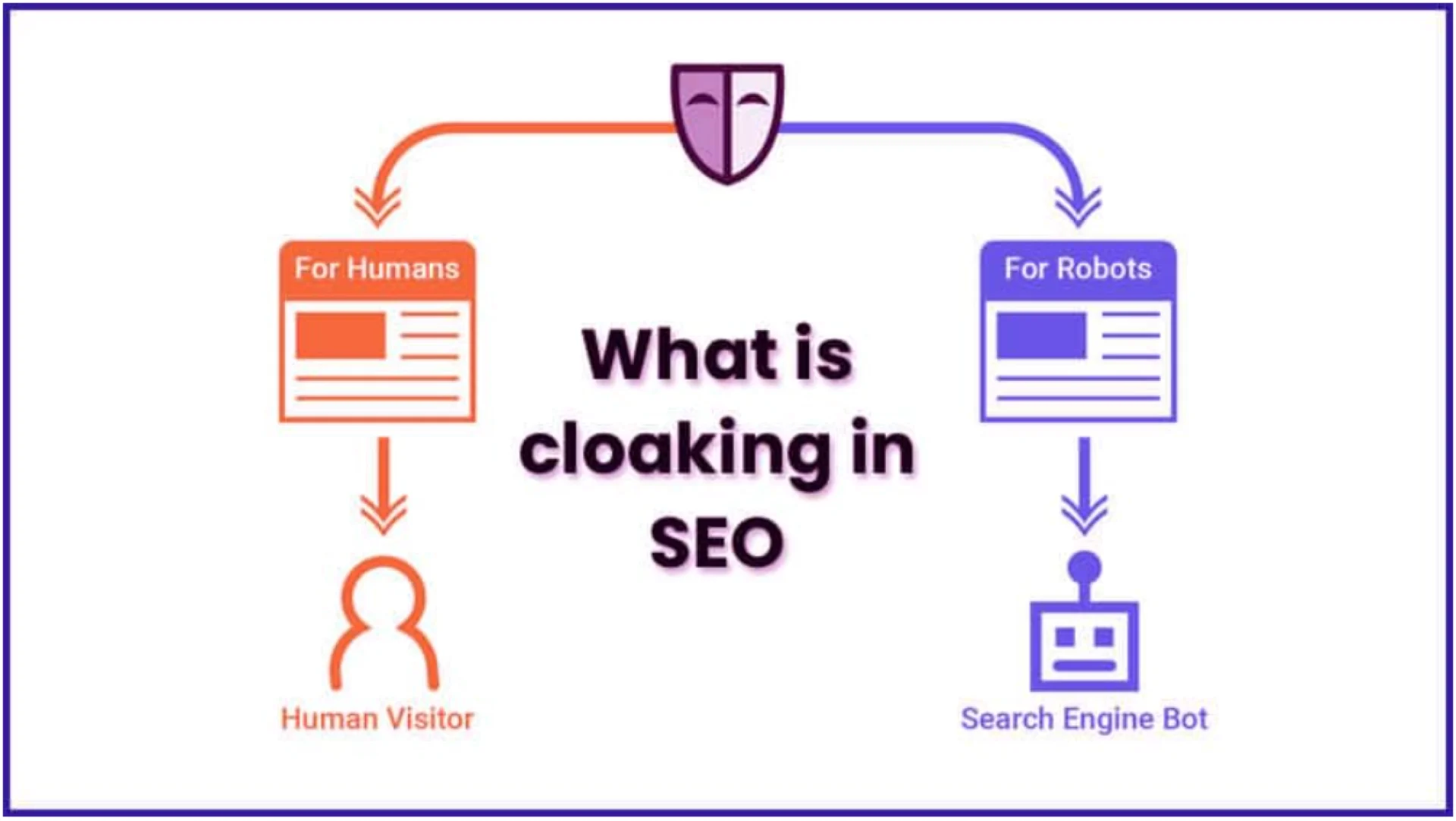
3. Build Link Networks or Use Private Blog Networks (PBNs)
Link building is a central part of SEO, and black hat tactics often focus here. One popular method is setting up a private blog network – a group of websites, often built on expired domains with existing backlinks, created solely to link to a target site and inflate its authority.
Another approach involves using automated tools to generate thousands of backlinks through comment spam, forum profiles, or low-quality directories. Some may even buy backlinks from link farms or vendors on SEO forums.
These tactics aim to trick search engines into interpreting the site as popular or trusted based on link quantity. While updates like Google Penguin have reduced the effectiveness of link spam, many black hat practitioners still use these strategies, especially on disposable sites.
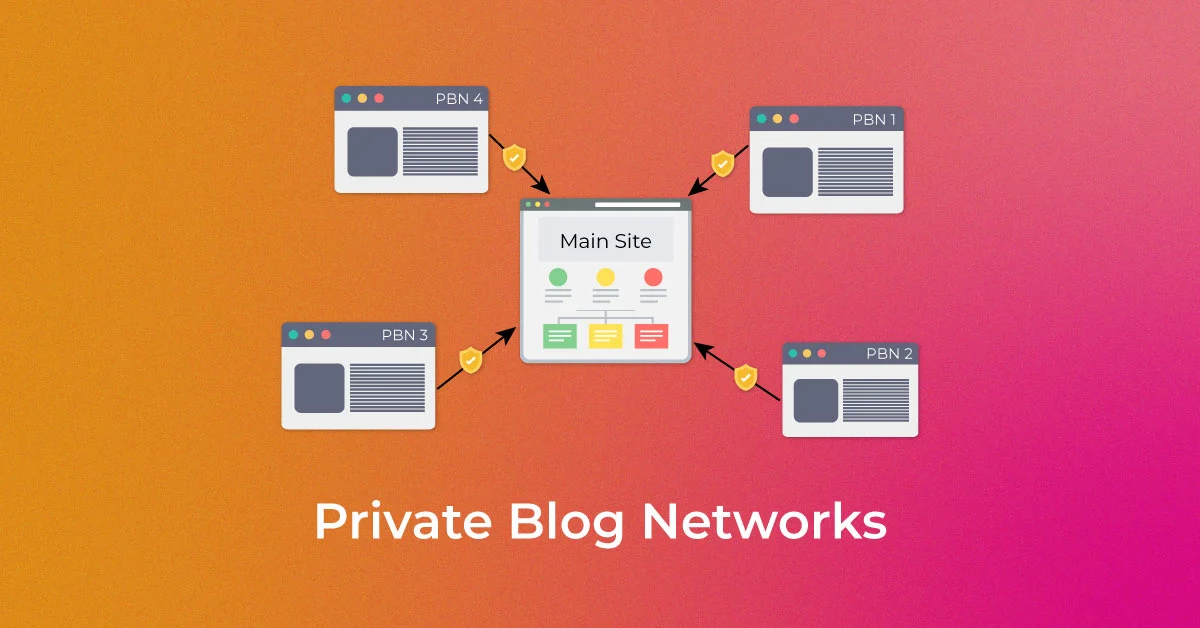
4. Create Doorway Pages to Funnel Search Traffic
Doorway pages are keyword-targeted pages created specifically to rank for variations of a search query and redirect users to a central site. For example, an e-commerce business might set up hundreds of pages like “Buy Bluetooth Speakers in [City]” that all lead to the same product listing.
These pages are usually low-quality, templated, or copied, designed only to catch long-tail traffic and direct it elsewhere. In some setups, doorway pages might include auto-redirects, or simply link heavily to the main site.
While doorway pages have been targeted by Google for years, they are still used, particularly in local SEO schemes or affiliate projects where the content lifespan is intentionally short.
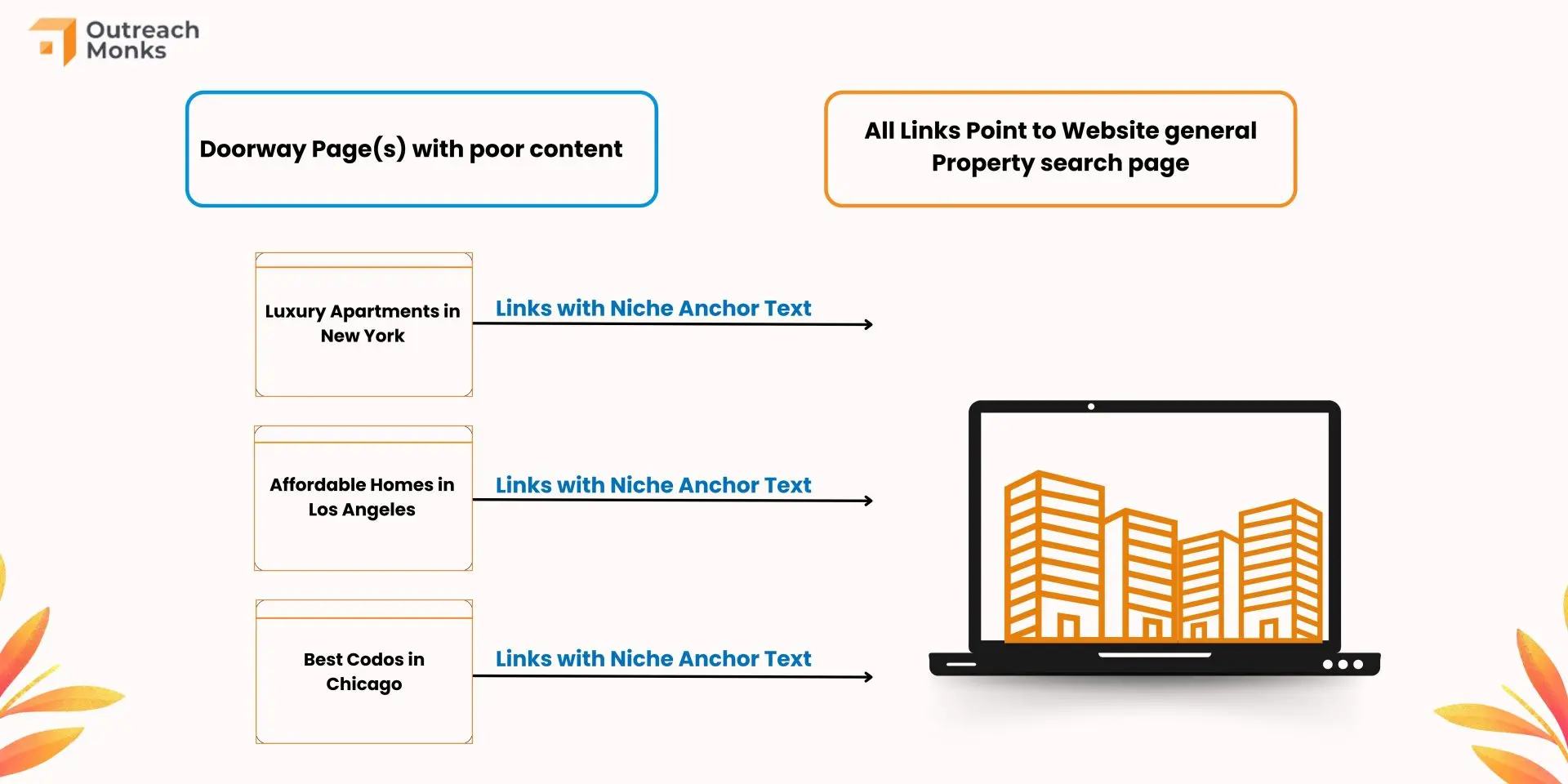
Should I Implement Black Hat SEO Methods?
You should consider implementing black hat SEO methods only if you fully accept the risks of penalties, short-term outcomes, and search engine guideline violations as part of your strategy.
These methods are typically used when fast visibility or traffic is more important than long-term search stability. They’re often applied in environments where sites are disposable, campaigns are short-lived, or competition is so intense that shortcuts are part of the operating model. In such cases (like certain affiliate marketing setups or churn-and-burn e-commerce projects), the goal is to benefit quickly, knowing the tactics may stop working or be penalized at any time.
On the flip side, for brands that rely on consistency, customer trust, and long-term search presence, black hat methods usually carry more downside than upside.
That said, black hat SEO is not a technical barrier – it’s a strategic choice. Some marketers apply it selectively to test theories or explore algorithmic gaps. Others use it in parallel with white hat efforts, often separating risky tactics from core brand assets. There’s also a grey zone where marketers push boundaries while staying just under detection thresholds.
The key is being intentional. If you go this route, you’ll want to know exactly what the risks are, what kind of site you’re applying it to, and what your plan is if that site gets flagged or penalized. The methods can work, but they come with strings attached.
Not sure how bold your SEO play should be? EventTracker reveals if your page convinces… or just confuses.
How to Choose Best Black Hat SEO Services?
To choose the best black hat SEO services, look for providers who are transparent about their methods, experienced in short-term ranking strategies, and willing to work within the level of risk you’re comfortable with.
Most black hat services operate in less formal settings (private forums, closed communities, or through referrals), rather than polished agency websites. Promises of quick rankings, bulk link packages, or “secret” methods are common, and not necessarily a red flag if short-term wins are your goal.
However, it’s important to ask what techniques they use (PBNs, cloaking, spun content, etc.), how they handle penalties, and whether you’ll retain control or visibility over the assets they build. If someone avoids those questions, it’s often a sign that the strategy could be too aggressive or unstable, even for black hat standards.
Your tactics are bold, and your landing page should be, too. Craft it your way, with full control.
How to Become a Black Hat SEO Expert?
To become a black hat SEO expert, you need a deep understanding of how search algorithms work, combined with technical skills, constant experimentation, and a high tolerance for risk.
Many black hat practitioners begin by studying SEO fundamentals (ranking factors, link equity, indexing, crawl budgets), and then shift into testing tactics that push or break the rules. These experiments are often run on disposable domains to observe how algorithms respond to different manipulations without jeopardizing valuable assets.
Technical proficiency is also essential. Black hat SEOs often automate tasks using tools like GSA Search Engine Ranker, ScrapeBox, or XRumer, and may use proxies, spinners, or cloaking scripts to manage risk and scale their tactics. Staying active in private communities and forums like BlackHatWorld is part of the learning curve, as strategies evolve quickly and are often shared discreetly.
Some learn black hat SEO purely out of curiosity or for competitive analysis. Others treat it as a full-time strategy, especially in high-competition niches or for short-term monetization projects. In any case, becoming proficient in this area requires ongoing trial and error – success is often temporary, and failure is frequent.
No matter your SEO style, a high-converting landing page is where the real results begin.
Is Black Hat SEO Unethical?
Black hat SEO is considered unethical because it relies on manipulation, deception, and tactics that violate agreed-upon platform rules.
These methods are designed to mislead either the search engine (through cloaking, link schemes, or hidden content) or users (through bait-and-switch content or fake signals). While not illegal in most cases, black hat SEO breaks the implicit rules of fair competition in organic search. It prioritizes ranking by trickery rather than by relevance or value, which is why many in the SEO industry (and most brands) view it as unethical, even if it’s still widely practiced.
What are the Black Hat SEO Practices to Avoid?
When deciding to use black hat SEO, avoid keyword stuffing, cloaking, hidden text, link farms, doorway pages, scraped or spun content, and rich snippet abuse – these are the most common tactics likely to trigger penalties or fail to deliver lasting results. To stay on the safe side, it’s best to avoid black hat SEO altogether.
Keyword stuffing involves cramming excessive keywords into content and meta tags, making the page unnatural to read. Cloaking serves different content to users and search engines, often leading to ranking removal. Hidden text and links (using CSS tricks or color matching) are now easily detected. Link farms and private blog networks artificially inflate backlink profiles but are frequently caught and nullified. Doorway pages use thin, repetitive content to funnel traffic and are often blacklisted.
Scraping or spinning content creates low-value pages that duplicate or rephrase existing material without adding anything useful. Similarly, misusing structured data to show fake review stars or manipulate snippets can lead to manual actions.
These techniques may seem efficient, but they’re widely recognized and targeted by search engine algorithms. Even within aggressive SEO circles, many of them are seen as obsolete or too risky for the return they provide.
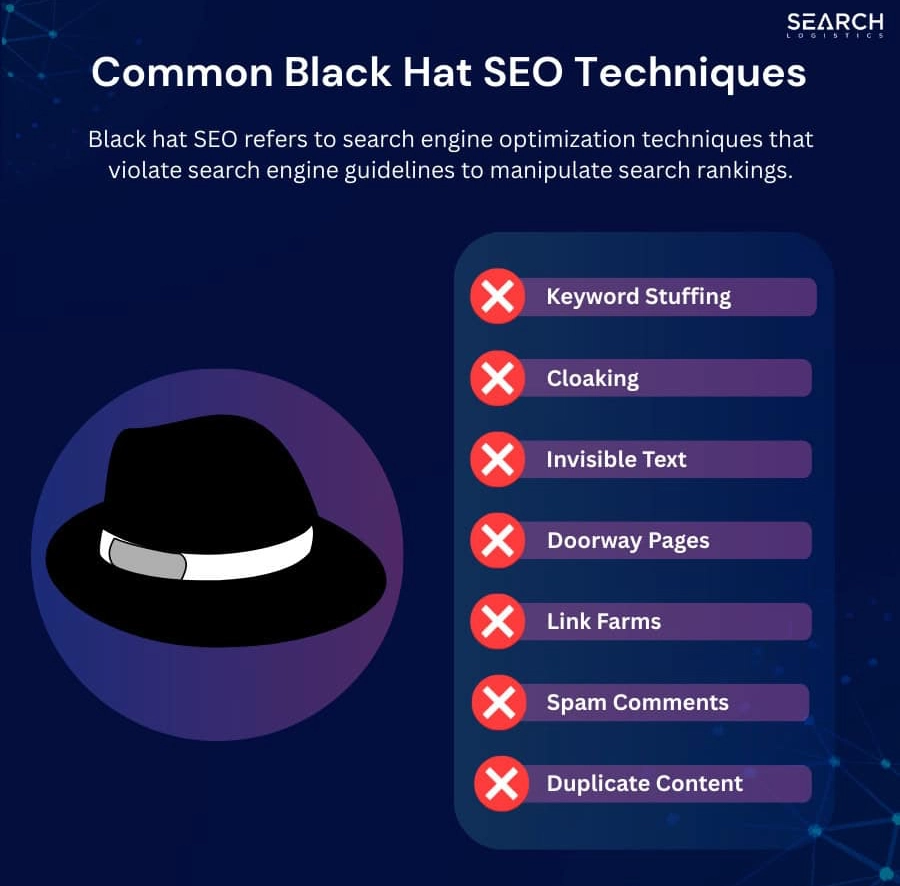
Why do People Use Black Hat SEO?
People use black hat SEO because it promises fast results, can be automated at scale, and appeals to those operating in highly competitive or short-term environments.
For some, speed is the main motivator. Ranking quickly (especially in niches like affiliate marketing, adult content, or high-volume product categories) can mean the difference between profit and invisibility. Black hat tactics offer ways to bypass the slower process of building trust, links, and quality content. For others, it’s a cost issue: spinning content, auto-generating backlinks, and cloning site structures require less time and fewer resources than doing it all manually and by the book.
In some cases, people use these tactics because they don’t know they’re considered risky. They may hire a low-cost service promising thousands of backlinks or rapid rankings without realizing what’s involved. Others are more strategic – they treat domains as temporary, expecting them to rank, profit, and get penalized, then start over. In such models, black hat isn’t a backup plan – it’s the core strategy.
You’ve got the traffic—now make it work for you. Optimize every click with a landing page builder designed for high conversions.
What is the Difference Between Black Hat SEO and Grey Hat SEO?
The difference between black hat SEO and grey hat SEO lies in how directly they violate search engine guidelines – black hat tactics clearly break the rules, while grey hat methods operate in areas that aren’t explicitly forbidden but still push boundaries.
Black hat tactics include cloaking, keyword stuffing, and link schemes – methods Google has clearly labeled as violations. Grey hat tactics might involve using expired domains for SEO value, spinning content lightly, or publishing guest posts primarily for backlinks. These aren’t directly banned, but they can become problematic depending on how they’re used.
Grey hat SEO often appears less risky but can still lead to penalties if abused or flagged in future updates. The key distinction is intent: black hat aims to deceive, while grey hat plays in the gray areas of what’s allowed.
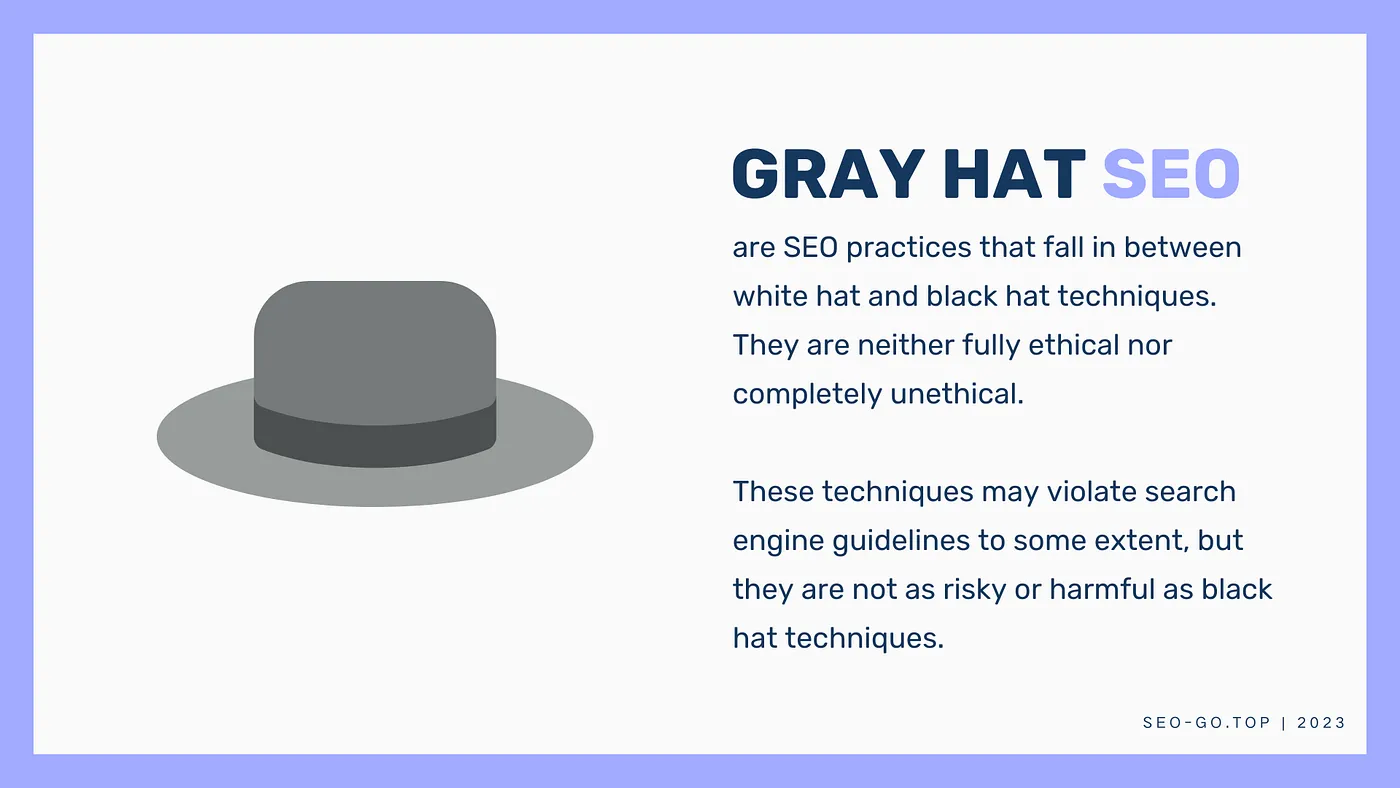
What is the Difference Between Black Hat SEO and White Hat SEO?
The difference between black hat SEO and white hat SEO is that black hat focuses on manipulating algorithms to gain rankings quickly, while white hat SEO tactics follow search engine guidelines and aim to provide genuine value to users.
Black hat tactics include deceptive strategies like cloaking, hidden links, and spammy link schemes. White hat, on the other hand, relies on quality content, proper site optimization, ethical link building, good user experience, and thorough keyword research.
While black hat is often faster but short-lived, white hat SEO strategies are slower but more sustainable. One is built around loopholes; the other is built to last.
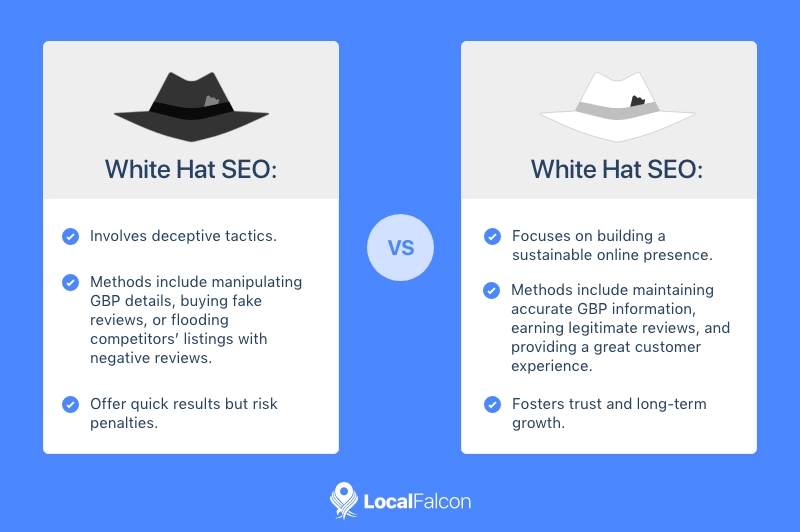
What is the Best Black Hat SEO Tool?
The best black hat SEO tool depends on the tactic being used, but tools like GSA Search Engine Ranker, ScrapeBox, and XRumer are among the most widely used for automating link building, comment spam, and large-scale content promotion.
GSA Search Engine Ranker can generate thousands of backlinks automatically across forums, wikis, blogs, and directories. ScrapeBox is known for scraping search results, harvesting URLs, and automating blog comment submissions. XRumer specializes in creating forum profiles and posting at scale, often bypassing captchas and filters. Other tools, like The Best Spinner or RankerX, focus on content spinning and Web 2.0 automation.
What is the Role of Landing Pages in Black Hat SEO?
The role of landing pages in black hat SEO is to serve as optimized entry points designed primarily for search engines. Often, they are used with the goal of redirecting or funneling traffic to another destination.
These pages are typically created in bulk, each targeting specific keyword variations or locations – what Google refers to as doorway pages. They’re often low in content quality, duplicated across domains or subfolders, and loaded with exact-match keywords. The focus isn’t on user engagement but on capturing search visibility and sending the visitor elsewhere, whether to an offer page, affiliate link, or a different website altogether.
Sometimes, these pages are cloaked or set to redirect instantly. Other times, they’re used as part of a larger link-building strategy, existing solely to manipulate rankings and not to convert users.
Forget confusing SEO hacks. Create landing pages that earn trust and clicks.
What are the Limitations of Black Hat SEO?
The limitations of black hat SEO include short-lived results, a high risk of penalties, limited scalability on trusted brands, and the constant need to stay ahead of algorithm updates. Most black hat tactics work until they’re detected. Once flagged by Google’s systems or caught manually, rankings can drop overnight, or the site can disappear from search altogether. For businesses that rely on stability, this unpredictability makes black hat a poor fit.
There’s also the issue of diminishing returns. As search engines evolve, previously effective tactics lose power. Maintaining rankings often requires constant reinvention, testing, and domain replacement. While it may suit short-term projects or throwaway sites, black hat search engine optimization tends to lose effectiveness when applied to long-term business assets.
Use Black Hat SEO to Improve Traffic on Your Landing Pages
Using black hat SEO to improve traffic on landing pages is possible, but it comes with trade-offs. These tactics can generate quick spikes in visibility by targeting specific keywords, automating content creation, or building link structures that push pages up the rankings. For landing pages built purely to capture traffic or redirect visitors, that can be effective – at least temporarily.
However, long-term success requires more than manipulating algorithms. Whether you’re running paid campaigns, testing variations, or building a full sales funnel, it’s often more effective to use landing pages that are flexible, easy to optimize, and built with real users in mind.
Tools like Landingi can help with that. You can quickly create, duplicate, and manage landing pages – whether for SEO experiments, PPC campaigns, or performance testing. If you’re experimenting with traffic strategies, having a platform that gives you control over structure, layout, and A/B testing without coding can be a practical advantage. And you can try it for free.
In the end, whether you’re exploring black hat SEO out of curiosity or competitive necessity, understanding the mechanics behind it gives you an edge. But if your goal is to build lasting visibility and user trust, the tools and tactics you choose will matter just as much as your strategy.





